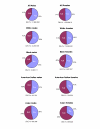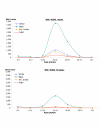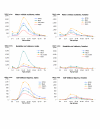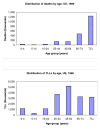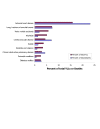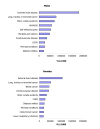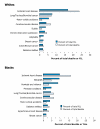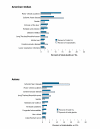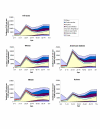The burden of disease and injury in the United States 1996 - PubMed (original) (raw)
doi: 10.1186/1478-7954-4-11.
Matthew T McKenna, Stephen Begg, Niels Tomijima, Meghna Majmudar, Maria T Bulzacchelli, Shahul Ebrahim, Majid Ezzati, Joshua A Salomon, Jessica Gaber Kreiser, Mollie Hogan, Christopher J L Murray
Affiliations
- PMID: 17049081
- PMCID: PMC1635736
- DOI: 10.1186/1478-7954-4-11
The burden of disease and injury in the United States 1996
Catherine M Michaud et al. Popul Health Metr. 2006.
Abstract
Background: Burden of disease studies have been implemented in many countries using the Disability-Adjusted Life Year (DALY) to assess major health problems. Important objectives of the study were to quantify intra-country differentials in health outcomes and to place the United States situation in the international context.
Methods: We applied methods developed for the Global Burden of Disease (GBD) to data specific to the United States to compute Disability-Adjusted Life Years. Estimates are provided by age and gender for the general population of the United States and for each of the four official race groups: White; Black; American Indian or Alaskan Native; and Asian or Pacific Islander. Several adjustments of GBD methods were made: the inclusion of race; a revised list of causes; and a revised algorithm to allocate cardiovascular disease garbage codes to ischaemic heart disease. We compared the results of this analysis to international estimates published by the World Health Organization for developed and developing regions of the world.
Results: In the mid-1990s the leading sources of premature death and disability in the United States, as measured by DALYs, were: cardiovascular conditions, breast and lung cancers, depression, osteoarthritis, diabetes mellitus, and alcohol use and abuse. In addition, motor vehicle-related injuries and the HIV epidemic exacted a substantial toll on the health status of the US population, particularly among racial minorities. The major sources of death and disability in these latter populations were more similar to patterns of burden in developing rather than developed countries.
Conclusion: Estimating DALYs specifically for the United States provides a comprehensive assessment of health problems for this country compared to what is available using mortality data alone.
Figures
Figure 1
Proportion of cardiovascular disease deaths (excluding stroke) assigned to selected codes for ill-defined causes and directly assigned to ischemic heart disease in the United States.
Figure 2
Burden of Disease (DALYs) by sex and major disease groups, US, 1996.
Figure 3
Groups I, II, and III as a percentage of total burden of disease (DALY) by race, US, 1996.
Figure 4
Distribution of YLL and YLD by sex and race, US, 1996.
Figure 5
HIV/AIDS: distribution of DALY rates/100,000 by age, race and sex, US 1996.
Figure 6
IHD and cerebrovascular diseases: distribution of DALY rates/100,000 by age, race and sex, US 1996.
Figure 7
Hypertension and inflammatory cardiac diseases: distribution of DALY rates/100,000 by age, race and sex, US 1996.
Figure 8
Major causes of injuries: distribution of DALY rates/100,000 by age, race and sex, US 1996.
Figure 9
Distribution of deaths and YLL by age, US 1996.
Figure 10
Ten leading causes of mortality burden and death, as per cent of total, both sexes, US 1996.
Figure 11
Leading causes of mortality burden (YLL) by sex, US, 1996.
Figure 12
Ten leading causes of mortality burden (YLL) and death, as a per cent of total, by race, US, 1996.
Figure 13
Ten leading causes of mortality burden (YLL) and death, as a per cent of total, by race, US, 1996.
Figure 14
Comparative rankings for the twenty leading causes of YLL for males, US compared with selected non-US OECD countries. Note: Vertical red bars indicate the range between minimum and maximum rankings observed in the selected OECD countries (excluding the US). Blue horizontal lines indicate rankings for the US. The ten selected non-US OECD countries are: Australia, Canada, France, Germany, Greece, Italy, Japan, Netherlands, Spain and the United Kingdom.
Figure 15
Comparative rankings for the twenty leading causes of YLL for females, US compared with selected non-US OECD countries. Note: Vertical red bars indicate the range between minimum and maximum rankings observed in the selected OECD countries (excluding the US). Blue horizontal lines indicate rankings for the US. The ten selected OECD countries are: Australia, Canada, France, Germany, Greece, Italy, Japan, Netherlands, Spain and the United Kingdom.
Figure 16
YLL rankings by race in the US compared with selected non-US OECD countries, males. Note: Vertical red bars indicate the range between minimum and maximum rankings observed in the selected OECD countries (excluding the US). Blue horizontal lines indicate rankings for the US. The ten selected OECD countries are: Australia, Canada, France, Germany, Greece, Italy, Japan, Netherlands, Spain and the United Kingdom
Figure 17
YLL rankings by race in the US compared with non-US OECD countries, females. Note: Vertical red bars indicate the range between minimum and maximum rankings observed in the selected OECD countries (excluding the US). Blue horizontal lines indicate rankings for the US. The ten selected OECD countries are: Australia, Canada, France, Germany, Greece, Italy, Japan, Netherlands, Spain and the United Kingdom
Figure 18
Distribution of YLD for non-communicable cause groupings.
Figure 19
Age patterns of mental disorders and diseases of the nervous system.
Figure 20
Patterns of YLD by age and race, US 1996.
Similar articles
- Assessing the burden of disease in the United States using disability-adjusted life years.
McKenna MT, Michaud CM, Murray CJ, Marks JS. McKenna MT, et al. Am J Prev Med. 2005 Jun;28(5):415-23. doi: 10.1016/j.amepre.2005.02.009. Am J Prev Med. 2005. PMID: 15894144 Review. - Singapore's burden of disease and injury 2004.
Phua HP, Chua AV, Ma S, Heng D, Chew SK. Phua HP, et al. Singapore Med J. 2009 May;50(5):468-78. Singapore Med J. 2009. PMID: 19495514 - The burden of disease and injury in Serbia.
Jankovic S, Vlajinac H, Bjegovic V, Marinkovic J, Sipetic-Grujicic S, Markovic-Denic L, Kocev N, Santric-Milicevic M, Terzic-Supic Z, Maksimovic N, Laaser U. Jankovic S, et al. Eur J Public Health. 2007 Feb;17(1):80-5. doi: 10.1093/eurpub/ckl072. Epub 2006 Jun 3. Eur J Public Health. 2007. PMID: 16751634 - The global burden of disease in 1990: summary results, sensitivity analysis and future directions.
Murray CJ, Lopez AD, Jamison DT. Murray CJ, et al. Bull World Health Organ. 1994;72(3):495-509. Bull World Health Organ. 1994. PMID: 8062404 Free PMC article. - Global "burden of disease"-study for psychiatric disorders.
Ustün TB, Chisholm D. Ustün TB, et al. Psychiatr Prax. 2001 Jul;28 Suppl 1:S7-11. doi: 10.1055/s-2001-15381. Psychiatr Prax. 2001. PMID: 11533901 Review.
Cited by
- The impact of elective total hip and knee arthroplasty on physical performance in orthogeriatric patients: a prospective intervention study.
Kappenschneider T, Bammert P, Maderbacher G, Greimel F, Holzapfel DE, Schwarz T, Götz J, Pagano S, Scharf M, Michalk K, Grifka J, Meyer M. Kappenschneider T, et al. BMC Geriatr. 2023 Nov 21;23(1):763. doi: 10.1186/s12877-023-04460-6. BMC Geriatr. 2023. PMID: 37990164 Free PMC article. - Release of TGF-β3 from Surface-Modified PCL Fiber Mats Triggers a Dose-Dependent Chondrogenic Differentiation of Human Mesenchymal Stromal Cells.
Berten-Schunk L, Roger Y, Bunjes H, Hoffmann A. Berten-Schunk L, et al. Pharmaceutics. 2023 Apr 21;15(4):1303. doi: 10.3390/pharmaceutics15041303. Pharmaceutics. 2023. PMID: 37111788 Free PMC article. - Serum periostin level is not sufficient to serve as a clinically applicable biomarker of osteoarthritis.
Tan Q, Yang Z, Xin X, Yang B, Xing Z, Li F, Zhang K, Tian Y, Zhu T. Tan Q, et al. BMC Musculoskelet Disord. 2022 Dec 1;23(1):1039. doi: 10.1186/s12891-022-06017-x. BMC Musculoskelet Disord. 2022. PMID: 36451121 Free PMC article. - Homologous Use of Allogeneic Umbilical Cord Tissue to Reduce Knee Pain and Improve Knee Function.
Timmons RB, Sugaya K, Bane LD. Timmons RB, et al. Life (Basel). 2022 Feb 9;12(2):260. doi: 10.3390/life12020260. Life (Basel). 2022. PMID: 35207547 Free PMC article. - The Patients' Experiences of Burden of Neurofibromatosis: A Qualitative Study.
Foji S, Mohammadi E, Sanagoo A, Jouybari L. Foji S, et al. Iran J Nurs Midwifery Res. 2021 Jul 20;26(4):342-348. doi: 10.4103/ijnmr.IJNMR_178_20. eCollection 2021 Jul-Aug. Iran J Nurs Midwifery Res. 2021. PMID: 34422615 Free PMC article.
References
- Murray CJL, Lopez A. The Global Burden of Disease: a comprehensive assessment of mortality and disability from diseases, injuries, and risk factors in 1990 and projected to 2020. 1. Cambridge, Harvard University Press; 1996.
- Bank W. World Development Report 1993: Investing in Health. New York, NY, Oxford University Press; 1993.
- Field MJ, Gold MR. Summarizing Population Health: Directions for the development and application of population metrics. Washington, D.C., National Academy Press; 1998. - PubMed
LinkOut - more resources
Full Text Sources
Other Literature Sources



